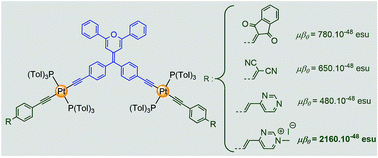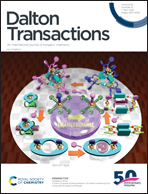Investigation of second-order nonlinear optical responses in a series of V-shaped binuclear platinum(ii) complexes†
Abstract
A series of four D–(π-Pt–π-A)2 new V-shaped binuclear platinum(II) complexes bearing a diphenylpyranylidene ligand as a pro-aromatic donor group (D) and various electron-attracting groups (A) separated by platinum bis-acetylide fragments have been synthesized, characterized and studied for their electrochemical, photophysical and second-order nonlinear optical (NLO) properties. The nonlinear optical properties of these complexes have been determined by using the Electric-Field-Induced Second Harmonic (EFISH) generation technique, and their optical properties have been rationalized by Time-Dependent Density Functional Theory (TD-DFT) calculations relying on a range-separated hybrid. All complexes display positive μβ0 values. In addition, the second-order NLO responses of the complexes could be easily modulated by incorporating various end-capped electron-attracting groups, namely malononitrile, indane-1,3-dione, pyrimidine and pyrimidinium. Remarkably, complex 7 bearing a pyrimidinium fragment displays the highest μβ0 value among all the complexes of this series. Its NLO response is twice as high as that of the mononuclear analogue complex RD2, which has been confirmed both experimentally and theoretically.



 Please wait while we load your content...
Please wait while we load your content...